The cost of the Ukraine war for one Russian regiment
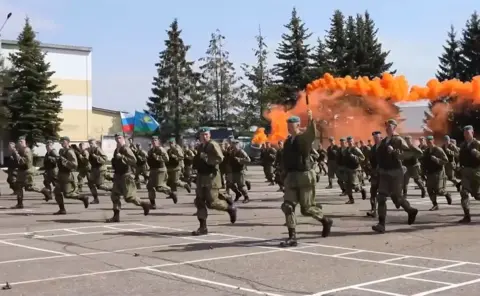 VDV Rossii
VDV RossiiKostroma is not a bad place to go looking for the effects of the Ukraine war on Russia. For this city is home to a celebrated regiment that bears its name and has been in the forefront of all the main battles in the Kremlin's campaign against its neighbours.
The 331st Guards Parachute Regiment, often called the Kostroma Airborne Regiment, has been the subject of investigations by BBC's Newsnight since shortly after last February's invasion. These have revealed the price paid by the regiment and its home community. We had confirmed 39 fatalities by April last year, 62 by late July, and now the toll has reached 94.
Much of the work compiling this list has involved combing social media accounts on V'Kontakte, the Russian equivalent of Facebook, and local media reporting. We can then cross reference this with satellite and Google Street View imagery.
One video discovered on V'Kontakte showed soldiers' graves at a cemetery north-east of Kostroma. The graves shown in the videos match the names of the soldiers we have collated.
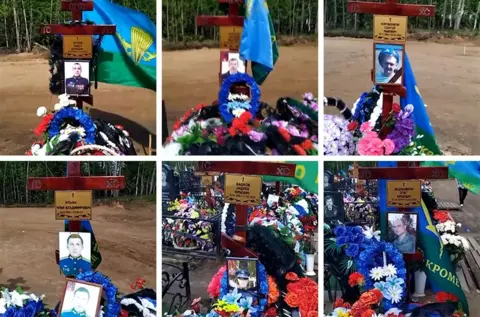 Pervaya Polosa
Pervaya PolosaThe actual number of 331st's dead is probably much higher. Some of the soldiers are from towns outside Kostroma, which makes tracking down information about them much more difficult. Several soldiers have been reported missing - some of these may count among the dead.
When one considers those seriously wounded or taken prisoner, it's reasonable to assume that the Ukraine war has cost the regiment several hundred soldiers.
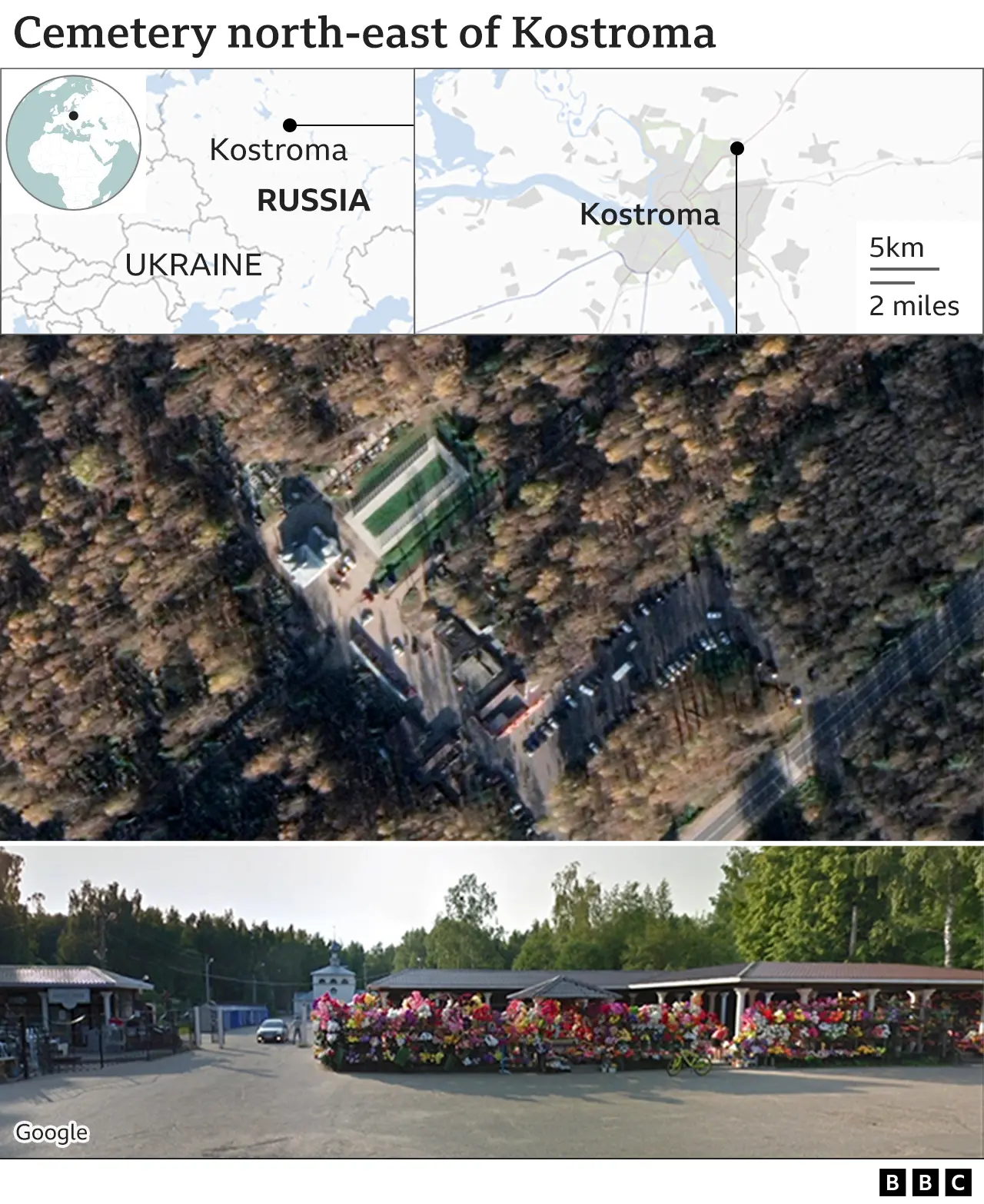
The loss of life has caused much comment in Kostroma, which lies about 300km (186 miles) north-east of Moscow and has a population of around a quarter of a million. One local website noted last spring that the entire Soviet-Afghan war, lasting nine years, had cost the city 56 soldiers. Heavy losses in Ukraine have given the local authorities a difficult task of political management.
Sergey Sitnikov, Kostroma's Kremlin-appointed governor, has been in the forefront of attempts to convince people that the city's soldiers are being properly supported. Gov Sitnikov's visits to hospitals, barracks, and indeed to the front, have been covered on local TV.
On a visit to the front in December, Gov Sitnikov told viewers that "we need to help [the] guys so they have decent conditions". He had brought with him crowd-funded care packages and commercially sold drones.
Gov Sitnikov is Vladimir Putin's placeman in his home region, so he's hardly a rebel or fearless teller of uncomfortable truths. But his willingness to visit the front and acknowledge shortcomings, even in a coded way, marks an interesting contrast with his boss.
When local TV showed mobilised paratroopers on the 331st's parade ground six months ago, it also carried Gov Sitnikov's rather frank remarks to them: "I'm wishing you good health, success, completion of all tasks… and that you return home alive."
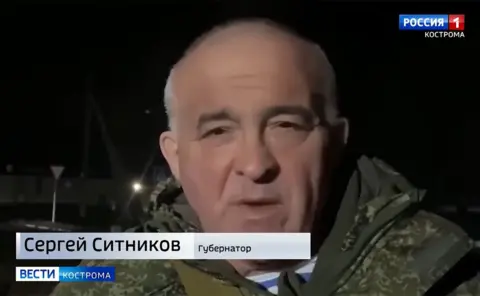 GTRK Kostroma
GTRK KostromaThe call-up of paratroopers, part of Russia's wider mobilisation, underlines the degree to which the Ukraine campaign has exhausted the country's professional army, of which the 331st has been a showpiece. In footage of November's parade, 150 conscripts were shown before their dispatch to the front.
The total size of the 331st regiment could be estimated at 1,500-1,700. When it first sent into Ukraine in February 2022, it deployed two battalion groups, giving a total of 1,000-1,200 soldiers. After taking heavy casualties in the failed attempt to reach Kyiv, the regiment was withdrawn and rebuilt in the southern Russian garrison town of Belgorod last summer.
Subsequent action has seen the regiment moving around all the major flashpoints - Izyum in the early summer, Kherson later on, and now back to Donbas. By monitoring the dates given in the death announcements on Kostroma social media, it's possible to work out when (and often where) the unit was used to spearhead assaults, and the lulls when it was removed from the line to lick its wounds. For example, a cluster of deaths in February point to elements of the 331st being engaged in Kreminna.

Mark Urban reports on how the Russian 331st Regiment, and their families, are coping with Vladimir Putin's long war

Each time casualty replacements - including the conscripts shown on TV in November - are brought in to replace losses, the original cadre of soldiers gets smaller, and the overall size of the unit diminishes. It may now number no more than 300-400 at the front.
The losses, and indeed the return of badly wounded men, have resonated in the home community. A few weeks into the war, one user of V'Kontake exclaimed, "Almost every day photos of our Kostroma boys get published. It sends shivers down my spine. What's happening? When will this end?"
Local media has been featuring commemorations of fallen Kostroma soldiers. In December, a TV station featured the unveiling of a plaque to Eduard Reunov, a paratrooper in the 331st who was killed in Ukraine. The style of this memorial and the language used in the report can be seen as an attempt to channel the Great Patriotic War (as the Russians call their 1941-45 fight against the Nazis), implying that today's soldiers are engaged in an equally important cause.
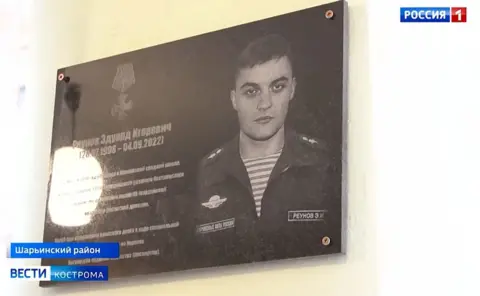 GTRK Kostroma
GTRK KostromaBut on social media, we've found more modern manifestations of remembrance, and even people seeking revenge. Soldiers are shown holding shells with messages scribbled on them from Reunov's former classmates, and, supposedly, his family.
There's a trend seen in a few Russian garrison towns, for wives and mothers to post pictures of themselves with an absent soldier's uniform. One tearful mother of a dead paratrooper from the 331st remembers the Great Patriotic War, and adds, "I hope there will be stories written about our guys".
 GTRK Kostroma
GTRK KostromaThose questioning the sacrifice tend to get short shrift. "Ukraine isn't my Motherland, our boys are dying for nothing," one person recently wrote on Kostroma's V'Kontakte page. Another swiftly countered, "That's a stupid opinion. No point in writing that stuff here".
It's evident from coverage of Gov Sitnikov's activities that the authorities are trying to mollify those who are anxious about the killed and wounded. It's not clear how much support the war has from the wider Russian public, but the video we've seen suggests there's a good deal of solidarity among military families in Kostroma.
The 331st's decline can also be measured in loss to machinery as well as personnel - particularly airborne infantry combat vehicles, known by the Russian initials BMD - that have been used up in successive battles.
Initially, when the 331st was part of an Airborne Forces task force pushing towards Kyiv, we had difficulty identifying its vehicles in video of the fighting. A painted "V" was used to identify units from all of the various units in that task force, and an inverted triangle symbol with a "3" in the centre was also used by one other regiment apart from the 331st.
As the fighting wore on, soldiers in the 331st added a further ad hoc marking to the V on their vehicles' sides - an exclamation mark painted next to the V. They may have done this precisely so their commanders could distinguish their armour from the other regiments'.
Consequently we were able to identify individual BMDs from the 331st being loaded up on railcars in March 2022, following their withdrawal from Ukraine. They then reappeared in Donbas during last summer's fighting.

Open source analysts have also identified at least 25 destroyed BMDs marked in this way, by combing Ukrainian military social media accounts. As with the dead soldiers, this visible loss does not represent the total, since many other BMDs belonging to the Kostroma regiment have likely been lost outside the view of Ukrainian troops.
A report broadcast in February 2023 by the Russian network NTV shows an "armoured group" of the 331st in action in Luhansk. But it just tends to confirm the impression we've gleaned from other sources that the regiment survives as small detachments able to spearhead certain missions. From the call signs seen on camera this element consists of just three BMD armoured vehicles.
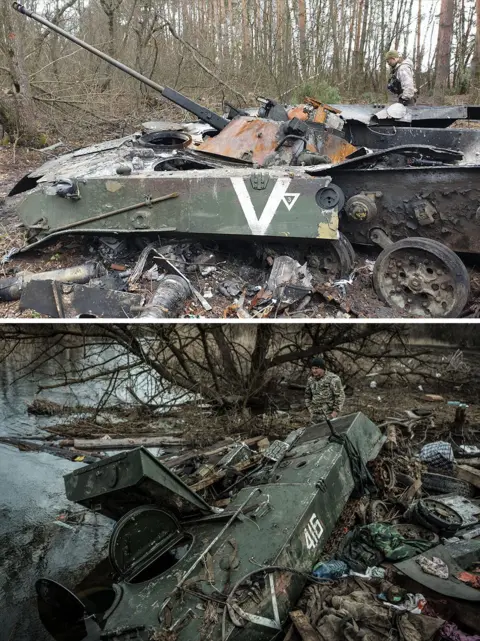 WarSpotting
WarSpotting So, the regiment's long war goes on. Of the war's wider effects on the Ukrainian population you will glean little from Russian media, nor is there any frank coverage of war-crime allegations.
The 331st were accused of massacring hundreds of Ukrainian soldiers during fighting in 2014. For many Ukrainians, the latest Russian losses may seem like nothing more than the paratroopers getting their just deserts.
Meanwhile, in Kostroma's graveyard there is plenty of evidence of the price of failure in Russia's invasion. Buried too is the regiment's reputation as "the best of the best", and its dreams of easy victory.
Additional research Maria Jevstafjeva and Louis Harris-White
